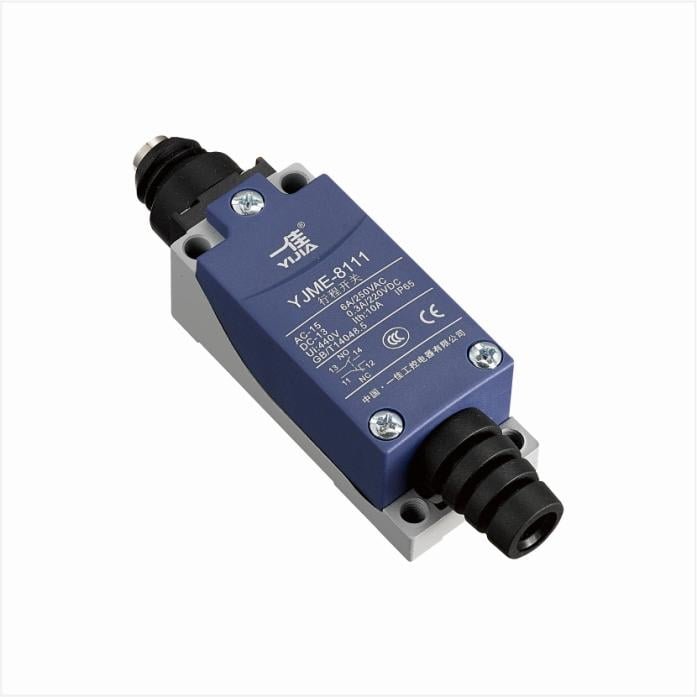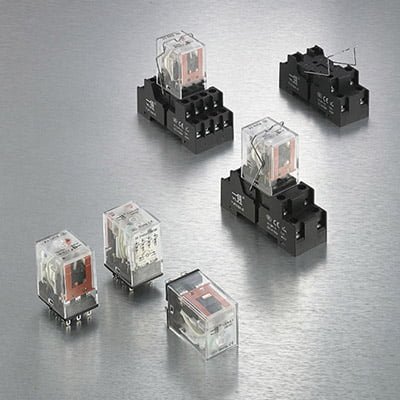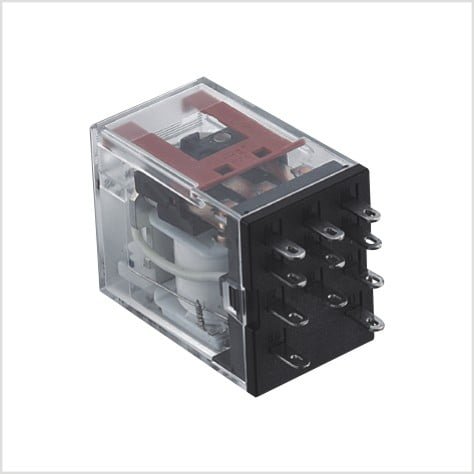Functions, working principles and applications of AC relay switches
What is an AC relay switch?
AC relay switch is an electrical component used to control AC circuits. It uses electromagnetic principles to achieve on-off control of the circuit. When a control signal (usually a low voltage or low current signal) is applied to the input end, the electromagnetic coil inside the relay generates a magnetic field, attracting or releasing the armature, thereby changing the contact state of the output end and realizing the opening and closing of the circuit. AC relay switches are widely used in industrial automation, household appliances, intelligent control systems and other fields. Due to their high reliability, fast response speed and long life, they have become an indispensable and important device in circuit control.
The core components of the relay include electromagnetic coils, armatures, contacts, etc. When the control signal disappears, the electromagnetic coil loses its magnetic force, the armature returns to its original position, the contacts are reset, and the circuit is disconnected. In this way, the AC relay switch can effectively isolate the control circuit and the controlled circuit to ensure the safety and stability of the circuit.
Advantages
AC relay switches have many significant advantages in various application scenarios, making them a widely used component in circuit control.
- High reliability: AC relay switches have long service life and stable performance, and can work reliably in various environmental conditions, reducing equipment failures and maintenance costs.
- Electrical isolation: The relay achieves complete electrical isolation between the control circuit and the controlled circuit through electromagnetic principles, avoiding the impact of high voltage or high current on the control circuit, and improving the safety and reliability of the system.
- High sensitivity: The relay can respond to very low control signals (voltage or current) and is suitable for occasions requiring precise control, such as automation systems, smart homes, and precision instruments.
- Multi-contact form: Relays usually have multiple contact configurations (such as normally open contacts and normally closed contacts), which can flexibly meet the needs of different circuit designs and provide more control options.
- Wide range of applications: AC relay switches are suitable for a variety of voltage and current levels and can be widely used in industrial control, household appliances, communication equipment, transportation and other fields.
- Strong anti-interference ability: Because the relay uses mechanical contact switching, it is less susceptible to electromagnetic interference than electronic switches and is suitable for use in complex electromagnetic environments.
- Simple and easy to use: The design and use of relays are relatively simple, without complex circuit design and debugging, and can be easily integrated into various equipment and systems.
Applications of AC relay switches
AC relay switches play an important role in many fields. Here are some of the main application scenarios:
- Industrial automation control: AC relay switches are widely used in industrial automation control systems to control the start and stop of motors, pumps, valves and other equipment. The electrical isolation and high reliability of relays can ensure the stable operation of industrial equipment.
- Household appliances: In household appliances, such as washing machines, air conditioners, refrigerators, etc., AC relay switches are used to control the on and off of the power supply, realize various automation functions, such as temperature control, timer switches, etc., and improve the intelligence level of household appliances.
- Lighting control: Relays are often used for switch control of lighting systems, especially in intelligent lighting systems. By cooperating with sensors and controllers, automatic switching of lights, dimming and other functions are realized to improve energy efficiency and user experience.
- Communication equipment: In communication equipment, AC relay switches are used to control the switching of signal paths and power management to ensure the reliability and stability of communication equipment.
- Transportation: Relays play a key role in transportation systems, such as railway signal control and traffic light control. Through reliable switch control, the safe and efficient operation of the transportation system is ensured.
- Security systems: In security systems, such as fire alarms and intrusion detection, AC relay switches are used to trigger alarm devices, control access control systems, etc., to provide security.
- Power management: Relays are widely used in power management devices such as uninterruptible power supplies (UPS) and generator automatic switching systems to ensure that in the event of a power failure, they can quickly switch to backup power to ensure the continuity of power supply.
How to choose an AC relay switch
Selecting the right AC relay switch is essential to ensure the reliability and stability of the circuit. During the selection process, the following key factors need to be considered:
- Voltage and current rating: The selected relay must be able to withstand the operating voltage and current in the circuit. The rated voltage and rated current of the relay need to be determined according to the specific application scenario to ensure that it can work stably without overload.
- Contact type: Select the appropriate contact type according to the needs of circuit control. Common contact types include normally open contact (NO), normally closed contact (NC), and changeover contact (CO). For example, when controlling the switch of the device, the normally open contact is more suitable, while when used in the safety circuit, the normally closed contact may be more suitable.
- Number of contacts: Select a relay with an appropriate number of contacts according to the complexity of the control circuit. When controlling a single circuit, one contact is sufficient, while when controlling multiple circuits, a multi-contact relay needs to be selected.
- Control signal requirements: The control coil voltage and current of the relay should match the control circuit. Ensure that the control signal can reliably excite the action of the relay. Common control signal voltages include 5V, 12V, 24V, etc.
- Response time: Different application scenarios have different requirements for the response time of relays. In control systems that require fast response, it is particularly important to choose relays with fast response speed.
- Environmental conditions: Consider the working environment conditions of the relay, such as temperature, humidity, vibration, etc. Select relays that adapt to specific environments to ensure that they can still work reliably under harsh conditions.
- Size and installation method: The size and installation method of the relay should match the equipment or control cabinet. Select relays with appropriate size and installation method according to the actual installation space for easy installation and maintenance.
- Brand and quality: Choose relays with well-known brands and reliable quality to ensure product performance and service life. You can refer to user reviews and industry recommendations to choose products with good reputation.
Maintenance and care
In order to ensure the reliability and service life of AC relay switches, regular maintenance and care are necessary. Here are some key maintenance and care measures:
Regular inspection:
- Appearance inspection: Regularly check the appearance of the relay for signs of damage, deformation or burning. Ensure that the surface of the relay is clean and free of dust and dirt.
- Contact inspection: Check the wear of the relay contacts and ensure that the contacts are clean and free of oxidation. Use a special contact cleaner for cleaning when necessary.
Test function:
- Action test: Regularly test whether the relay operates normally and confirm that the relay can open and close reliably when the control signal is applied. The relay can be tested for on-off using a test instrument.
- Electrical performance test: Test the operation of the relay under rated voltage and current to ensure that its electrical performance meets the requirements.
Maintenance environment:
- Temperature and humidity control: Ensure that the temperature and humidity of the relay working environment are within the allowable range to avoid the influence of excessively high or low temperature and humidity on the performance of the relay.
- Anti-vibration: The relay should be installed in an environment with less vibration to avoid vibration damage to its mechanical structure.
Prevent overload:
- Load monitoring: Monitor the load current and voltage controlled by the relay to ensure that it does not exceed the rated parameters of the relay. Overload may cause relay contacts to burn or electromagnetic coils to be damaged.
- Short-circuit protection: Install appropriate short-circuit protection devices such as fuses or circuit breakers in the circuit to prevent short-circuit faults from damaging the relay.
Regular replacement:
- Replace aging parts: After a long period of use, the internal components of the relay may age or be damaged. Regularly check and replace aging electromagnetic coils, contacts and other parts to ensure the normal operation of the relay.
- Service life management: According to the mechanical and electrical life of the relay, record the number and time of use, and replace the relays that have reached their service life in time to avoid circuit problems caused by relay failure.
Protective measures:
- Install a protective cover: In an environment susceptible to dust, moisture or chemical corrosion, install a protective cover or encapsulation shell to protect the relay from the influence of the external environment.
- Electromagnetic interference protection: In an environment with strong electromagnetic interference, take appropriate shielding measures to prevent the influence of electromagnetic interference on the operation of the relay.
FAQ
What is an AC relay switch?
An AC relay switch is an electrical component that uses electromagnetic principles to control the on and off of an AC circuit. It drives the electromagnetic coil through a control signal, thereby attracting or releasing the armature, changing the contact state, and realizing the opening and closing of the circuit.
What is the working principle of an AC relay switch?
When a control signal is applied to the electromagnetic coil of the relay, the coil generates a magnetic field to attract the armature, change the contact state, and realize the on and off of the circuit. When the control signal disappears, the electromagnetic coil loses its magnetic force, the armature returns to its original position, the contacts are reset, and the circuit is disconnected.
What is the difference between an AC relay switch and a DC relay switch?
AC relay switches are used to control AC circuits, while DC relay switches are used to control DC circuits. Their electromagnetic coil designs and contact materials may be different to accommodate different current and voltage characteristics



